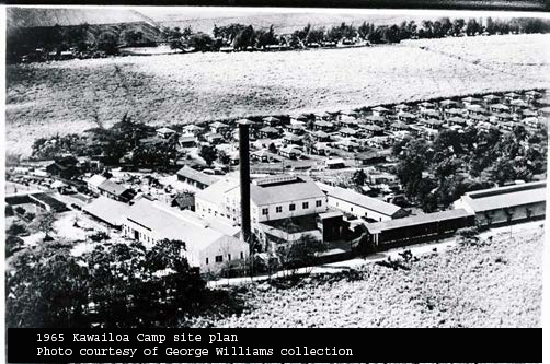By Boyd Ready, Local Historian
Many have wondered: where were the camps, how many were there, and what was life like in a workers’ camp during the 98 years of the Waialua Agricultural Company’s North Shore operations? I recently took another look at the George Williams Collection of maps of most of the camps from 1924, 1947, 1955, and 1972. They were called ‘camps’ as they were on lands recently cleared for sugar fields.
The field and mill work was hard, sweaty, and demanding. The first groups of workers were mostly unmarried men who lived in dormitories. When they married, a house with water, firewood, and later, power was provided. In the 1930s bathrooms went in. House repairs were done by the plantaion. In the early fifties houses were sold to many worker-residents at the depreciated value. Even today many retiree tenants remain in their homes as Dole has honored the promise of lifetime use.
Each camp was primarily of one ethnicity. Their natural affinity, common language, and arrival in groups with contracts, ensured this. Management’s interest in preventing strikes from the combined ethnic groups kept the camps that way for a long time. Out in the fields though, working together, using ‘pidgin’ creole English, and sharing food during breaks, a multi-ethnic sense of community grew.
There were 22 camps, including the small ‘pump’ camps for those tending the steam engines for the irrigation system. Some, like Mill Camp 8 and 9, or Kawailoa Camp, had over 100 homes, a store, a theatre, rec center, pool, church, and temple. Others, like ‘Kemoʻo Camp 4,’ near the old Halstead Mill smokestack, had 16 homes, and some had just 2 or 3. The largest, apart from the Mill Camps in Waialua town, were Ranch Camp, Helemano Camp, Opaeula Camp, Kawailoa Camp, Kemoo Camp, and Waimea Camp.
Since most workers did not have vehicles, independent businesses traveled to the camps and sold meat, fish, vegetables, fruits, and household goods to them. Even the Bank of Hawaii initially provided banking services to the camps. Outdoor screenings of films were sometimes arranged for the remote camps
I asked one of our directors, Cy Yamanoha, what it was like growing up in ‘Old Mill Camp’ the 16 or so homes makai of Thompson Corner. He said it was a great way to grow up. He remembered strikes and enduring cash shortages by reliance on ‘strike kitchens.’ Kids could roam outside, pick fruit, and play in Poamoho stream. He remembers a makeshift canoe of corrugated roofing and 2X4’s, with roof mastic to patch the seams, and the boys laughing and paddling, heading to shore when they started to sink!
It is clearly normal for farmers to live on their farms. Many North Shore farmers today hope this will be allowed again like the plantation workers did in years past.



